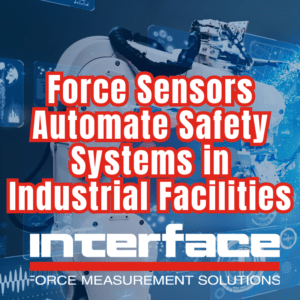Force Sensors Automate Safety Systems in Industrial Facilities
 Automation has become a critical facet of the industrial sector as companies utilize robotics, cobots, IoT, and other sensing technologies to improve efficiency and output. However, production is not the only area of manufacturing benefiting from automation.
Automation has become a critical facet of the industrial sector as companies utilize robotics, cobots, IoT, and other sensing technologies to improve efficiency and output. However, production is not the only area of manufacturing benefiting from automation.
Worker safety and equipment monitoring are also getting a major boost from automation. Measurement sensors enable this new safety and alarm system automation wave.
Interface sensors have long been used to help automate monitoring systems in industrial machines found in manufacturing facilities. These sensors can help provide accurate data for continuous process controls of various machines on a production line or elsewhere. Deviations in that data identify issues where a machine may need to shut down or come down for maintenance abruptly. The automation functions enabled by sensors drive efficiency by notifying engineers before any disruption to production while also improving safety by avoiding malfunctions that could put workers at risk.
As the collaborative use of automation and technology has progressed, so have regulations around worker safety within industrial facilities. Robust safety systems, built with force and other sensor tech, are growing in use and application. The systems and sensor-enabled equipment are pervasive in manufacturing, whether part of cobots working on the production line or designing and testing equipment to move packages in a warehouse. Accurate measurement is quintessential to workplace safety and automation.
Included below is a list of some of the systems and machines that utilize Interface force sensors in both the testing and monitoring stages to improve workplace safety:
- Lockout and Safety Alarms
- Overload Protection for Heavy Equipment
- Weighing and Scale Device Alarms
- Industrial and Collaborative Robots (Cobots)
- Automated Guided Vehicles (AGVs)
- Assembly Line Equipment and Conveyor Belts
- Crane and Lift Equipment Systems and Monitoring
- Automated Palletizing Systems
- Industrial Presses
- Filling Machines
- Testing and Inspection Equipment
- Ergonomic Workstations and Tool Safety
The main benefits of using force sensing within these applications include the precision and accuracy of data and the ability to optimize processing using this data (especially over time). Here’s how:
Precision and Accuracy: Load cells and torque transducers provide highly accurate measurements of force and rotation, respectively. This allows for precise control of automated machinery, ensuring consistent product quality and reducing errors. Less rework and higher-quality products contribute to a safer work environment, as there’s less chance of operators needing to fix mistakes or handle malfunctioning equipment.
Process Optimization: Manufacturers can gain valuable insights into their machines’ operations by precisely measuring forces and torques. This data can be used to optimize processes, identify inefficiencies, and reduce waste. Optimized processes with smoother operation result in fewer chances of equipment malfunction and potential safety hazards.
Safety Measures: Interface sensor devices can be designed into automated machines, tools, and equipment to measure safety during use. For example, our transducers can detect overloads or excessive torque, which could lead to equipment failure and injure workers. These sensors help prevent accidents and create a safer work environment by triggering alarms or automatic shutdowns.
As noted, safety measures are required with collaborative robots in industrial facilities. Safety testing and equipment monitoring are needed to ensure humans and robots can work together. In this example, Interface suggests using four 3-axis Force Load Cells (creating one 6-axis Force Plate) installed between two metal plates at the base of the cobot. By installing a 6-axis force plate under the cobot and two ConvexBT Load Button Load Cells in the pinchers of the cobot, if a human were to knock into the cobot or have a limb stuck in the pincher, the cobot would sense the amount of force measured from the load cells and be programmed to stop immediately. This safety and automation solution protects the equipment and, most importantly, the worker.
Quality Control: Accurate measurement of forces and torques allows for real-time product quality monitoring. This enables manufacturers to identify and address any deviations from specifications early in production, reducing the risk of defective products reaching the customer. Fewer defective products mean less chance of needing rework or repairs later, keeping workers out of harm’s way.
Force sensor technology has played a key role in the evolution of modern industrial facilities as a tool to improve production while benefiting quality and powering workplace safety and health. It is one of the backbone solutions found in automation systems, and it offers highly accurate data to not only benefit real-time monitoring but also improve processes over time. Find additional manufacturing solutions and applications here.
ADDITIONAL RESOURCES
Powering Up Precision Machine Building and Automation Webinar
Force Sensors Advance Industrial Automation
Automation and Robotics Demands Absolute Precision
Force Measurement Testing Improves Products and Consumer Safety
Interface Solutions for Safety and Regulation Testing and Monitoring
Crane Block Safety Check App Note
Crane Safety Requires Precision Measurements Ship to Shore








